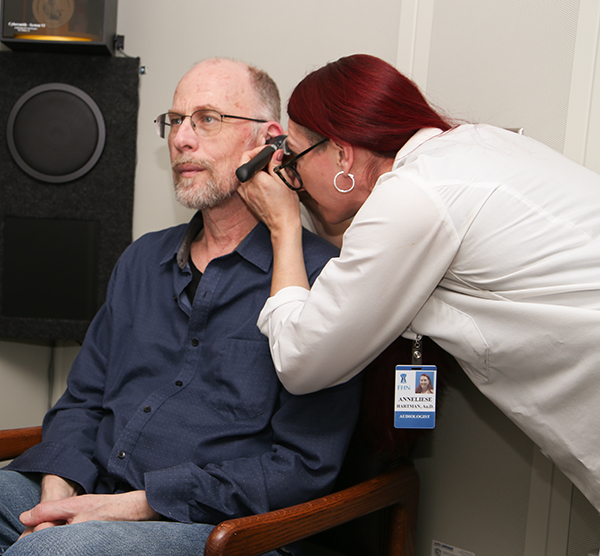
Using sophisticated screening equipment, Dr. Anneliese Hartman tests Sam’s hearing sensitivity at different frequencies in the FHN Audiology Lab.
Sam Tucibat spent most of his summer “in a tube” – and it helped him recover from hearing loss.
The tube was a hyperbaric oxygen treatment (HBOt) chamber at The Center for Wound Healing at FHN Memorial Hospital in Freeport. “It was actually very restful,” he says.
Waking up with impaired hearing, however, was anything but restful. It was disconcerting and “alarmingly sudden,” according to Sam. “I couldn’t hear from my right side, and immediately called Dr. Martinez (his FHN primary care provider). I was able to see him promptly, and thought that maybe he would find a wax buildup that could be easily remedied. But Dr. Martinez suspected something more. He referred me to ENT Dr. Shawn Shianna, who got me in on the same day. My exam and tests showed Sudden Sensorineural Hearing Loss, which is idiopathic – there is no known cause, though research suggests a viral injury may be the culprit. Something just goes awry within the inner ear.”
Dr. Shianna teamed with FHN Audiologist Dr. Anneliese Hartman, AuD, who did a comprehensive audiological evaluation. They prescribed steroids as the first line of treatment, and Sam took those for two weeks with no improvement. Their next recommendation? Hyperbaric oxygen therapy (HBOt), available at FHN’s Center for Wound Healing. This sophisticated equipment involves breathing 100 percent oxygen in a pressurized chamber to promote healing.
“I did a round of 20 treatments, Monday through Friday for four weeks,” explains Sam. “I noticed improvement, so we did another round of 20. I spent a lot of my summer in that tube, since each session lasts 2½ hours, but it was worth every minute. It did the job.”
Sam appreciated getting treatment close by. “It is great to have such sophisticated equipment near your hometown,” says Sam. “If I had to travel for the HBOt, it would have been a much more difficult process.”
Sam actually used his ‘tube time’ to sleep and meditate, and didn’t feel claustrophobic inside the chamber. “Since the tube is transparent, I felt fine,” he explains. “Patients can watch TV and talk to the medical assistants, and that helps, too.” He was very impressed with Jennifer Kerchner, RN, who helped him prepare for each treatment. He says, “She exemplified a great healthcare provider – professional, qualified, and compassionate.”
Dr. Hartman was pleased to see improvement in follow-up hearing tests, done periodically throughout the process. Using equipment in FHN’s state-of-the-art audiology lab, she could measure multiple variables in Sam’s hearing capabilities to monitor progress. “Thankfully, his profound hearing loss was improved by the HBOt to a more moderate level,” she shares. “I prescribed hearing aids to help make up the difference, and Sam has adapted very well.”
“I love my hearing aids!” exclaims Sam. “They are super hightech – programmable, small, and comfortable. They can even be used like hearing buds to listen to music or a podcast … pretty cool!”
The combination of HBOt and hearing aids has brought Sam’s life back to normal. “I was anxious and fearful about my hearing loss and disliked missing out on music and conversations,” he says. “But I felt confident once the FHN team coalesced around me. They anticipated my questions, explained everything thoroughly, and gave me plenty of time at each appointment. Now, I’ve stopped asking ‘What?’ all the time, which I know was frustrating for my family and friends. I am back to playing my guitar, able to hear in stereo. I am one of the lucky ones. I am very grateful to hear well again.”